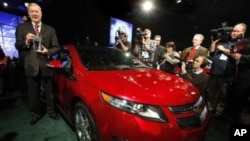General Motors is making a comeback in a big way. The U.S. automaker has emerged from bankruptcy and was star of the 2010 North American Auto Show in Detroit this week. GM’s plug-in electric Chevrolet Volt was named North American Car of the Year.
The Volt can travel 64 kilometers on its rechargeable batteries before a gasoline generator kicks in to extend its range to more than 450 kilometers. GM thinks its next generation Volt can go even farther, with a superior battery that holds twice as much energy.
Longer lasting power
The company has signed a license agreement to use lithium-ion battery technology developed at Argonne National Laboratory, a government-funded research facility. General Motors Ventures President John Lauckner says the move has great potential for GM’s entire electric-product line from "pure battery electric vehicles, extended-range electric vehicles or plug-in hybrid vehicles."
The new technology is a composite cathode material, a combination of lithium and manganese oxides. The battery can store twice as much electricity as conventional lithium-ion batteries and would greatly extend vehicle range and reduce its cost, making electric cars more attractive to consumers looking for energy-efficient transport. Lauckner says the cutting-edge technology is very promising. "The idea is that we want to get it on the road for the next generation of battery packs that come out in vehicles that General Motors offers around the world."
Equally hopeful is Mohamed Alamgir, research director for LG Chem, GM’s electric-car battery supplier. LG Chem, which also signed agreements with Argonne, is building a new factory and it expects mass production to begin next year.
Alamgir says refinements to the technology are still being made. "We are trying to increase the specific energy and the life of the battery and lower the cost. We are also doing a lot of work to improve, modify and tailor our chemistry to address those concerns and these broad set of patents give us the flexibility to carry out that work."
Closing competitive gap in electric car market
The new composite cathode could give GM a boost in its attempt to catch up to Asian automakers who currently dominate the electric car market.
Cathy Zoi, Acting under secretary of the U.S. Department of Energy says government investment in research and development and applied commercialization can pay off in economic growth and job creation. "DOE has invested about $400 million over more than a decade to support electric drive batteries and today we’re seeing a lot of return on these investments. In fact, the battery technology in almost all of the electric vehicles and hybrids on the road today were developed with DOE support."
In 2008 the U.S. manufactured just two percent of the world’s advanced batteries. Zoi expects that number to skyrocket. "By 2015 we’ll produce up to 40 percent, equivalent to 500,000 electric-drive vehicles per year. And that’s just fantastic."
Zoi adds that developing the electric car and other clean-energy industries will also help cut U.S. dependence on foreign oil and put the brakes on climate-changing carbon pollution.











